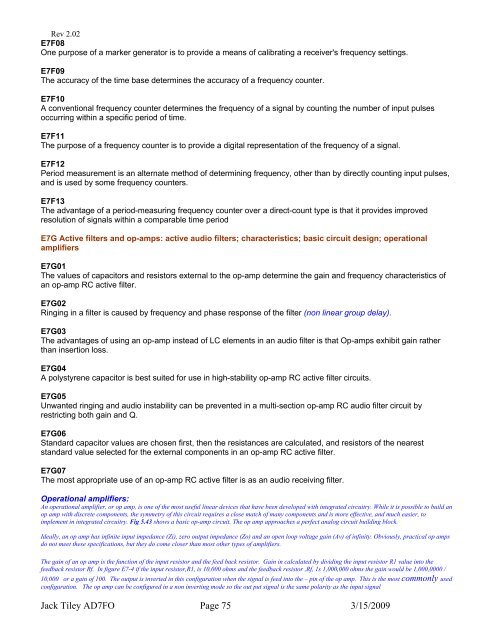Create successful ePaper yourself
Turn your PDF publications into a flip-book with our unique Google optimized e-Paper software.
Rev 2.02<br />
E7F08<br />
One purpose of a marker generator is to provide a means of calibrating a receiver's frequency settings.<br />
E7F09<br />
The accuracy of the time base determines the accuracy of a frequency counter.<br />
E7F10<br />
A conventional frequency counter determines the frequency of a signal by counting the number of input pulses<br />
occurring within a specific period of time.<br />
E7F11<br />
The purpose of a frequency counter is to provide a digital representation of the frequency of a signal.<br />
E7F12<br />
Period measurement is an alternate method of determining frequency, other than by directly counting input pulses,<br />
and is used by some frequency counters.<br />
E7F13<br />
The advantage of a period-measuring frequency counter over a direct-count type is that it provides improved<br />
resolution of signals within a comparable time period<br />
E7G Active filters and op-amps: active audio filters; characteristics; basic circuit design; operational<br />
amplifiers<br />
E7G01<br />
The values of capacitors and resistors external to the op-amp determine the gain and frequency characteristics of<br />
an op-amp RC active filter.<br />
E7G02<br />
Ringing in a filter is caused by frequency and phase response of the filter (non linear group delay).<br />
E7G03<br />
The advantages of using an op-amp instead of LC elements in an audio filter is that Op-amps exhibit gain rather<br />
than insertion loss.<br />
E7G04<br />
A polystyrene capacitor is best suited for use in high-stability op-amp RC active filter circuits.<br />
E7G05<br />
Unwanted ringing and audio instability can be prevented in a multi-section op-amp RC audio filter circuit by<br />
restricting both gain and Q.<br />
E7G06<br />
Standard capacitor values are chosen first, then the resistances are calculated, and resistors of the nearest<br />
standard value selected for the external components in an op-amp RC active filter.<br />
E7G07<br />
The most appropriate use of an op-amp RC active filter is as an audio receiving filter.<br />
Operational amplifiers:<br />
An operational amplifier, or op amp, is one of the most useful linear devices that have been developed with integrated circuitry. While it is possible to build an<br />
op amp with discrete components, the symmetry of this circuit requires a close match of many components and is more effective, and much easier, to<br />
implement in integrated circuitry. Fig 5.43 shows a basic op-amp circuit. The op amp approaches a perfect analog circuit building block.<br />
Ideally, an op amp has infinite input impedance (Zi), zero output impedance (Zo) and an open loop voltage gain (Av) of infinity. Obviously, practical op amps<br />
do not meet these specifications, but they do come closer than most other types of amplifiers.<br />
The gain of an op amp is the function of the input resistor and the feed back resistor. Gain in calculated by dividing the input resistor R1 value into the<br />
feedback resistor Rf. In figure E7-4 if the input resistor,R1, is 10,000 ohms and the feedback resistor ,Rf, 1s 1,000,000 ohms the gain would be 1,000,0000 /<br />
10,000 or a gain of 100. The output is inverted in this configuration when the signal is feed into the – pin of the op amp. This is the most commonly used<br />
configuration. The op amp can be configured in a non inverting mode so the out put signal is the same polarity as the input signal<br />
Jack Tiley <strong>AD7FO</strong> Page 75 3/15/2009


